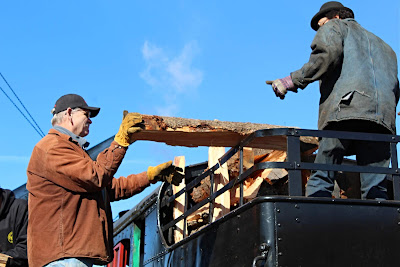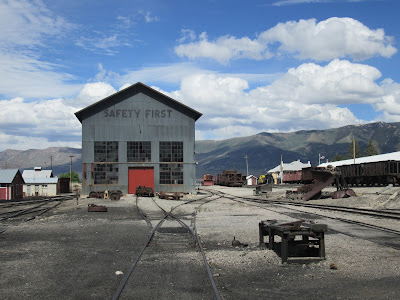Cover art for "The Steam Locomotive"
I have always liked books. I know its certainly a stereotype of my generation to paint us as screen enslaved and never having touched a book in our lives... but even as a little kid I found myself reading a lot. Part of it traces back to memories of elementary school libraries, Scholastic book fairs, and the like. I remember the first time I heard of Union Pacific's Big Boy locomotive was in some sort of DK cross section book. I voraciously read everything I could get my hands on from Star Wars, Lego, and other favorites of mine growing up. In Junior High School I remember going on a bit of a Jules Verne kick, reading the likes of 20,000 Leagues Under the Sea and Around the World in 80 Days. The library was the place to hang out in-between classes; and it became more so in High School were after lunch my friends and I would browse the bookshelves or break out the library's chess set before we had to head back to class.
One of the books I remember the most from my High School library that I first encountered sometime in 2008 or 2009 or so was part of the school's small selection on railroad technology. Jim Boyd's The Steam Locomotive Century of North American Classics was just the right style of large coffee table book with beautiful photographs and excellent writing to capture my attention. The book was published in 2000, and covers many preserved steam activities from the 1960's onto its publishing date. The book was produced collaboratively between Boyd and the Railfan and Railroad team, and Barnes and Noble's MetroBooks arm.
For me, the early 2010's were a different time in railfanning. Facebook was still the platform to connect with grandparents and long lost friends; its use to host hobby discussions really hadn't blossomed yet. There was (and still isn't) no reason in hell to pay money to use a discussion forum with a paid subscription service like Train Orders then. My only railfanning connection was really the small, free to use, and teetering on near constant collapse RR.Picture.Archives website and the occasional copy of Model Railroader that showed up in local grocery stores. I had no way of really knowing that Jim Boyd the author of the book I so often read in the library had written countless other railfan books and articles for Railfan and Railroad where he worked for many years as chief editor. I had no idea that he died in early January of 2011 while I was still in my junior year of High School.
But Jim's book opened up a world for me. Before opening its pages; I honestly knew almost nothing about the many of the subjects in the book. UP's Steam Program before then was only a vague memory of an opening shot from Shining Time Station with UP 844 and small whispers of Utah's own Echo Canyon being like a holy ground for Union Pacific's steamers. NW 611, Southern 4501, and even SP 4449; had I ever heard of them before that book... only existed as snippets in my mind before then. Jim Boyd's book in many ways opened up a larger world of railfanning beyond what I was familiar with growing up in the shadow of the Tooele Valley.
Of course now, The Steam Locomotive feels almost like a time capsule of a world almost lost. Yes there are indeed evergreen faces in Jim's book; 844 and 4449 in particular stand out, with other stalwart engines like ATSF 3751 and NKP 765 also highlights of the pages. But the book also highlights engine's who's sound of their whistles are now distant memory and have returned to static display, stuck in long restorations or are in storage; such as C&O 614, PRR 1361 and even UP 3985. In the eight years going on since I graduated High School, I have grown increasingly curious how The Steam Locomotive would hold up under modern inspection. So I ordered a copy of Amazon, and decided to give the book a fresh glance over!
One of the first observations getting the book and flipping through its pages... in a way this almost reads "in memory of..." 20 years after it was published. I counted about 46 preserved steam engines featured in the book focusing on those that were shown in operation (plus the static photo of C&O 1309 because a restoration effort on the engine would start many years after the book was published). Of those 46 engines, only 12 of them are still operational with about 6 or 7 undergoing current restorations to operations. Not surprisingly many of the engines still operational in the present day are some of the big celebrities of the preservation world, NKP 765, SP 4449... you get the picture. One of the engines showcased in the book was even Britain's LNER 4472 Flying Scotsman during its brief North American tour, meaning that of the 12 engines still presently operational; at least this one isn't even in the Western Hemisphere anymore!
A sample of the standard page and photo layout of the book.
This is in part due to the book's narration focusing on the development of North American mainline steam. As such the popular 2-8-0's and 4-6-0's that remain staples of the current historic railway circuit, get only a brief mention before the larger 4-8-4's and other big modernized engines take the center stage. It certainly helps create a cohesive narrative of America's motive power growing over the years from the diminutive start with engines such as John Bull up to the mighty articulated at the twilight of the steam age.
Of course one of the sadder tales from the book is the mid-60's failed steam program operated by Richard Jensen. Boyd doesn't shy away from publishing a photo of Jensen's GTW 5629 being scrapped, with its flues exposed to the open air as the torches come down upon it. CB&Q 5632, another one of Jensen's former locomotives gets its own spotlight including its briefly lived gold scheme; is like the GTW engine now in the "roundhouse in the sky." CB&Q 4960, one of Jensen's other engines though remains in service to this day at the Grand Canyon Railway in Williams, Arizona as Grand Canyon 4960; so there is indeed one silver lining to the tragic collapse of the Jensen steam program.
Speaking of silver linings and a touch of grey... Boyd is obviously a big fan of The Grateful Dead. Its a bit of an interesting experience realizing how much Jerry Garcia is being channeled into the book by Boyd. Even UP 8444's roll out in Greyhound paint doesn't escape Boyd showing off his status as a Deadhead. It helps to flavor the text, even if it firmly dates Boyd's age and creates a bit of a generational gap while trying to read this book.
Salmon colored highlight pages pull out unique pieces of history or steam technology from the main body text in the book.
Many of the programs Boyd mentions are now currently stalled or have been trapped in long restorations; such as PRR 1361's long process to return to steam that is still ongoing, or C&O 614's two decade long absence from mainline action with only a touch of green paint and a few static displays marking its entire 21st century activity. Perhaps the most upsetting engine to see sidelined is Cotton Belt 819, which had been restored by a small town effort that Boyd writes about very well, and is currently waiting an eventual restart in its restoration. Some engines, like the Pennsylvania Railroad engines used on the Strasburg, have gone onto become static museum display pieces. Of course, when I first read this book all those years ago I had no clue that Southern Railway 4501 or NW 611 would have returned to steam in the years since, let alone have made trips on the Norfolk Southern mainline in the 21st century... so never say never when it comes to some of these steam locomotives.
There is oddly enough, a bit of future foretelling that Boyd never could have imagined would come true... The parting pages of his book are first dedicated to old black and white photos of the Pennsylvania Railroad's duplex locomotives, including the shark-nosed T1 class. 13 years after the book was published, and two years after Boyd's death a modern project to rebuild a T1 began with the T1 Locomotive Trust and their planned Pennsylvania Railroad 5550. While the original T1's are a memory, slowly piece by piece a new one is rising from cast steel.
Secondly, Boyd finishes his book with perhaps the most famous steam locomotive class of American history; UP's Big Boy. Boyd bets on the wrong horse, stating that perhaps UP 4012 at Steamtown and UP 4018 in Texas would be the prime candidates for restoration; ignoring the now famous locomotive that was sitting in a fair-park in Los Angeles at the time... and it seems clear Boyd doesn't guess it would be Union Pacific itself to tackle the restoration. But... his closing words on the subject feel almost prophetic:
"Will the 4012 or 4018- or any other Big Boy ever run again?
Absolutely.
Why?
Like Mount Everest, because it's there."
Some of my own photos taken in May of the restored Big Boy.
In May 2019, myself and countless other railfans witnessed that Mount Everest finally being climbed; when UP 4014 made its inaugural break in run from Cheyenne to Ogden for the Golden Spike 150th Anniversary celebration; and countless more would get to witness or re-witness 4014 in steam again over the coming year.
I can't help but wonder what Jim Boyd would think if he was still around now to see the current rail preservation scene. Yes, plenty of the locomotives featured in his book are now silent display pieces. But with UP 4014, Skookum, PRR 5550, Nashville 576, ATSF 2926, C&O 1309 and C&O 2716 all recently restored or in process of restoration/reconstruction... it seems the 21st century is about to be full of a new cast of steam locomotives that Boyd never could have imagined would someday be plying the rails once more. Particularly the support CSX has given Kentucky Steam with their C&O 2716 project seems to suggest that the old adage of "CSX doesn't allow steam trains on their railroad" might vanish once 2716 returns to the mainline. Not to mention the affect social media has had on exposing UP 4014 to tens of thousands of people during its multiple cross country journey's last year.
Maybe in another few years... the editors at Railfan and Railroad should maybe consider the idea that Jim Boyd's book will need a sequel... 😁
- Jacob Lyman
I am sure this is the music Boyd would want you to be listening to right now.



























































